
Low Earth orbit (LEO) spacecraft
Space is vast and mostly unknown to us. However, given the harshness of the environment, many hazards must be overcome for safe missions to and through space. These include severe temperature swings from chillingly cold to brutally hot, the potential to be struck by debris and ionic radiation.
Although some assume that radiation and temperature are primarily external considerations for spacecraft, the truth is far different. It is true that the hull of aerospace platforms are designed to minimize the effects of the environment on internal systems and people.
However, mission-critical electronic systems must be protected from both internal temperature variations and external hazards. These hazards include solar flares, galactic cosmic rays (GCRs), and trapped Van Allen belt radiation—all three of which are concerns for PCBAs and electronics in low-earth orbit (LEO) spacecraft.
For high-performance, mission-critical components, such as MPUs and FPGAs, operational interruptions and performance degradation can result in catastrophe. Therefore, digital sensors, such as the TMP461-SP from Texas Instruments, are employed to ensure these types of contingencies do not occur.
How the TMP461-SP Digital Temperature Sensor is Used
TI’s TMP461-SP is an advanced digital temperature sensor developed to be used aboard space vehicles. And as shown in the figure below, utilization of this integrated temperature sensor can save as much as ⅔ the board area needed for alternative discrete solutions.

TMP461-SP sensor overview
The TMP461-SP integrates the signal chain and data conversion using diode-connected transistors in contrast to other solutions that require separate signal chain and data conversion. Additionally, the sensor can be used to directly monitor internal thermal diodes within high-performance and typically high heat-producing components like microprocessors (MPUs), microcontrollers (MCUs), FPGAs, ADCs, DACs, and other application-specific integrated circuits (ASICs) at an accuracy of ± 2°C–a substantial improvement over the ± 4°C – 6°C that is common for other FPGA temperature sensors.
The TMP461-SP stands out as a Qualified Manufacturer List (QML) Class V or QMLV component certified for reliable operation in space and has the following features:
Features of the TMP461-SP
- Accurate local and remote diode temperature from -55°C to 125°C
- Only requires 35µA of operating current
- Local and remote temperature resolution of 0.0625°C
- Programmable digital filter
- Diode fault protection
- Series resistance cancellation
- η-factor and offset correction
- Two-wire and SMBus™ serial interface compatibility and pin-program addressing
For additional features, please see the TMP461-SP datasheet.
TMP461-SP Applications
A typical application implementation example for the TMP461-SP is shown below.
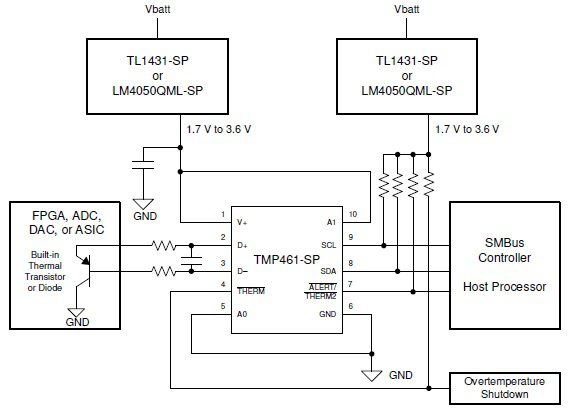
A typical application of the TMP461-SP
As shown above, the device includes over temperature shutdown protection and operates nominally between 1.7 V and 3.6 V.
Parameters and Specifications of the TMP461-SP
The TMP1651-SP comes in a 10-pin radiation-hardened HKU ceramic flat package (CFP). The metal lid and the thermal pad underneath are internally grounded. In the figure below, a detailed functional block diagram of the advanced sensor is shown.
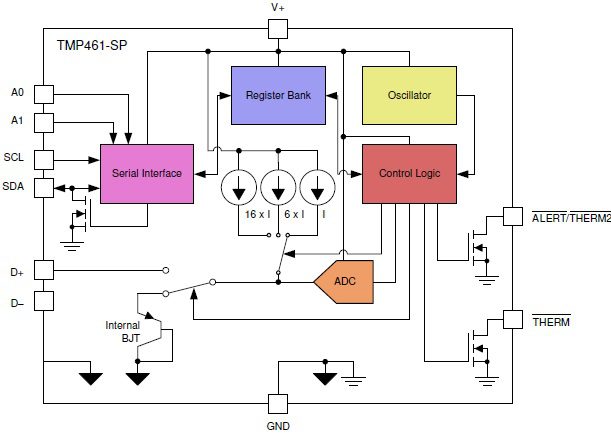
Block diagram of the TMP461-SP sensor
The timing requirements for two wire transfers are shown in the table below.
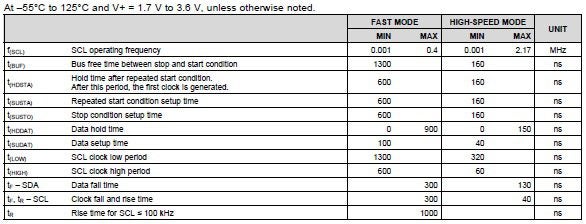
TMP461-SP 2-wire timing requirements
As indicated in the table above, the TMP461-SP can operate in two modes: fast (up to 400 kHz) and high-speed (up to 2.17 MHz).
Electrical and Thermal Specifications
The maximum ratings for the TMP461-SP are:

TMP461-SP maximum ratings
Electrical and thermal characteristics for various testing conditions are shown below.
 TMP461 SP electrical and thermal specifications
TMP461 SP electrical and thermal specifications
The Subgroups are listed below.
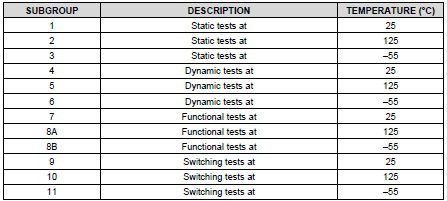
TMP461 SP electrical and thermal specifications
These refer to quality conformance inspections for MIL-STD 883, Method 5005 -Group A.
Designing with the TMP461-SP
The TMP461-SP allows for accurate temperature monitoring of high-performance devices such as FPGAs or the replacement of legacy NTC thermistors. In either case, you will likely gain significant real estate on your board using this advanced digital sensor rather than other alternatives where signal and data conversion are not integrated, not to mention significant accuracy for internal thermal measurements. For design, you have the option of using the 3D model shown below and laying out your custom design.
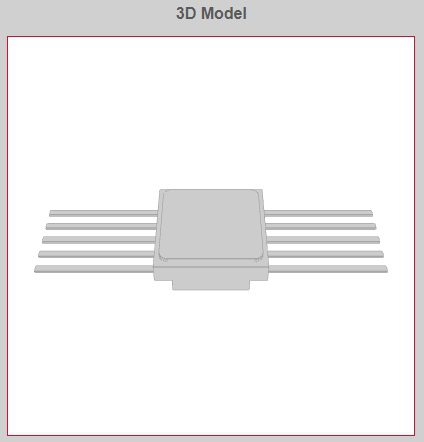
TMP461-SP 3D model from UL
In addition, TI offers an evaluation board, the TMP461EVM-CVAL module for development and direct utilization.
If you’re looking for CAD models for standard components or space-grade components like the TMP461-SP remote and local sensor, Ultra Librarian helps by compiling all your sourcing and CAD information in one place. Working with Ultra Librarian sets up your team for success to ensure streamlined and error-free design, production, and sourcing. Register today for free.








